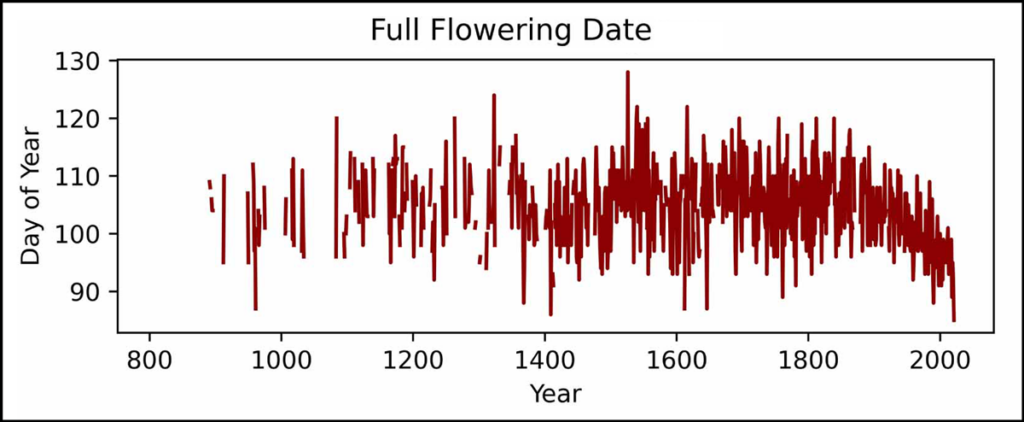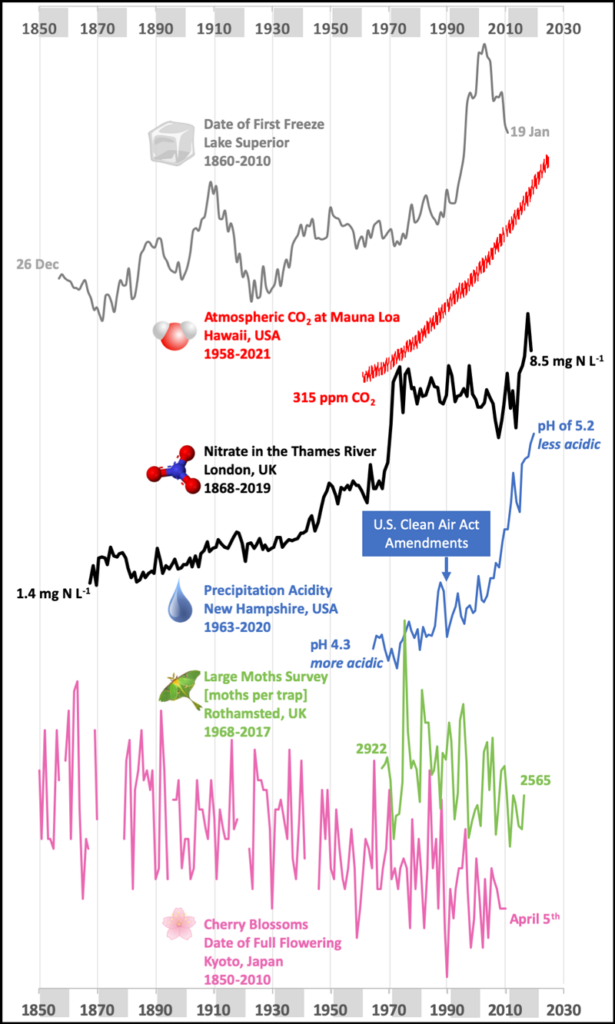In 2021, the famous cherry trees of Kyoto, Japan, reached their full flowering on 26 March, the earliest they had done so in more than 1,200 years. We know this because across the centuries, observers have recorded this important phenological and cultural event in imperial court diaries and newspaper advertisements [Aono and Kazui, 2008; Christidis et al., 2022]. The result of this recordkeeping over more than a millennium is an important and irreplaceable record of climate change, documenting later-than-average flowering dates during the cold periods of 1330–1350, 1520–1550, 1670–1700, and 1825–1830 and progressively earlier flowering dates since about 1900 as the influence of global warming has grown (Figure 1). This ancient data set persists as a clear, ongoing record of human impacts on the global environment—and perhaps it will someday demonstrate our ability to reverse those effects.

Human actions of ritual or curiosity have often led to data sets that provide important and unexpected insights into life and our interactions with the environment. Examples abound (Figure 2). In March 1958, Charles Keeling took the first of many measurements of atmospheric carbon dioxide (CO2) levels at Mauna Loa in Hawaii—in what would become the Keeling curve—measuring a concentration of 313 parts per million. In the succeeding year, Keeling’s routine daily measurements revealed the natural seasonal pattern of the biosphere’s “breathing”: Atmospheric CO2 declines rapidly during the Northern Hemisphere’s spring to summer transition, as growing plants take in the gas, and then gradually increases through winter [Keeling, 1960]. After just a few years of dedicated sampling, it became apparent that CO2 concentrations were not just oscillating seasonally; they were also increasing over time. As of 30 April 2023, the daily average atmospheric CO2 concentration measured at Mauna Loa was about 423 parts per million. The Keeling curve has provided compelling evidence—now replicated across global networks of CO2 monitoring stations—of how fossil fuel combustion has altered the chemistry of Earth’s atmosphere.
These cases show the tremendous power that long-term data sets can have, but their histories also vividly illustrate the fragility of such data sets.
Shortly after Keeling began his observations at Mauna Loa, Gene Likens, Herb Bormann, and Noye Johnson began measuring the chemistry of precipitation and stream water samples collected each week in the Hubbard Brook watershed in New Hampshire’s White Mountains. Their intention was to study nutrient inputs to and outputs from watershed ecosystems [Bormann and Likens, 1967], but they were quite surprised by the acidity of the rain samples they collected. Ultimately, this observation catalyzed decades of study and widespread monitoring of precipitation that proved acid rain was derived from the release of sulfur and nitrogen oxides from fossil fuel–fired power plants and that these acid inputs were harming forests and freshwaters [Likens and Bormann, 1974; Whelpdale et al., 1997]. The science was so convincing that it ultimately led to legislation, namely, the U.S. Clean Air Act and U.S. Clean Air Act Amendments, aimed at reducing emissions of these and other pollutants. Continued weekly sampling of precipitation chemistry at Hubbard Brook from 1963 to the present has documented the efficacy of this legislation in reducing the acidity of rain and snow as well as in mitigating legacy impacts of acid rain on the health of forests, soils, and streams [Likens et al., 1996; Likens, 2010].
These three cases show the tremendous power that long-term data sets can have, but their histories also vividly illustrate the fragility of such data sets. Kyoto’s cherry blossom record before the 1800s is reconstructed from ancient texts, and a recorded flowering date is missing for many years. Both Keeling and Likens and their respective teams faced budget cuts and funding gaps that at times threatened the continuation of their long-term records. And just recently, the eruption of Mauna Loa in late 2022 forced scientists to halt measurements for the Keeling curve atop the volcano and relocate to nearby Maunakea. (Atmospheric data collection resumed at Mauna Loa in mid-March.)
Some data sets are so valuable, so integral to our understanding of the world around us and our place in it, that leaving their continuation to the vagaries of fate or funding cycles is illogical and irresponsible.
Sustaining long-term environmental records, and sharing them with the world, always requires intention, attention, and dedicated financial support. There are likely many short-duration data sets that, had they been continued, could have had influence comparable to the examples from Kyoto, Mauna Loa, and Hubbard Brook. Most data sets that do survive over many years, decades, or longer are maintained not only by funding but also through some combination of good luck and sheer willpower. Still, most exist on a financial knife edge, always one rejected proposal or unfortunate happenstance away from being discontinued.
Long-term records that document the many dimensions of our changing natural world are incredibly valuable to society [Lindenmayer et al., 2012; Hughes et al., 2017; Schradin and Hayes, 2017]. They represent vital data for informing environmental policy and public communication, and unlike the model reconstructions and forecasts that are critical to most formal environmental change analyses, these data sets are remarkably easy for nonexperts to understand. We contend that some data sets are so valuable, so integral to our understanding of the world around us and our place in it, that leaving their continuation to the vagaries of fate or funding cycles is illogical and irresponsible. These data sets are part of humanity’s heritage and should be treated accordingly. We thus propose the need for an international organization to designate universally valuable long-term data sets as “World Heritage Data Sets.”
What Makes a World Heritage Data Set?
Much of the inherent value of long-term data sets is accrued over time, yet the challenge of maintaining funding increases alongside a record’s age. Scientific research agencies around the world tend to focus their attention on transformational research and ideas for new research that can address questions or produce results quickly. Furthermore, the majority of research grants last less than 5 years. The continuing availability of financial support is thus a major hurdle for most long-term data sets [Schradin and Hayes, 2017], as is the security of the collected data for future generations.
One might imagine that governments would recognize the need to support these crucial data resources—and sometimes they do—but in reality, there are many cases where government agencies have stopped collecting long-term data because of changing budgetary priorities, changes in leadership, or shifts in political priorities. For example, the U.S. EPA has suspended numerous air quality monitoring sites in its Clean Air Status and Trends Network, the U.S. Geological Survey (USGS) has had to terminate hydrologic monitoring at sites with decades-long records, and the USGS National Water-Quality Assessment program has stopped collecting new data.
The World Heritage Data Set designation would sustain the continuity of data collection and promote the data sets’ protection and widespread dissemination.
The idea to designate certain environmental records as World Heritage Data Sets was inspired by the protocols used by the United Nations Educational, Scientific and Cultural Organization to designate locations whose cultural and natural heritage represents “priceless and irreplaceable assets…of humanity as a whole” as World Heritage Sites. This designation increases a site’s global visibility, provides international standards for its preservation and protection, and entails access to UN funding for protection and repairs in the event of threats or damage from exceptional circumstances such as war or natural disaster.
We envision similar criteria and benefits developed by an international organization, such as the United Nations Environment Programme, for designating remarkably valuable long-term environmental records as World Heritage Data Sets. The designation would acknowledge these data sets for the crucial place-based insights they provide into the ways the natural world is changing and into humanity’s effects on our planet. It would also sustain the continuity of data collection and promote the data sets’ protection and widespread dissemination.
We suggest five key criteria that should be required for any environmental data set to be designated as a World Heritage Data Set. These data sets should be as follows:
1. High impact. A compelling case has been established in peer-reviewed literature that the data are currently, or are expected to become, outstandingly important for understanding basic or applied questions of high societal interest or importance.
2. Consistent. Attention to consistency in methods of collection, analysis, and recordkeeping has ensured a data set of the highest integrity and quality.

3. Sustained. The data record has persisted well beyond the length of the average grant cycle.
4. Available. The data set is freely available to all and includes sufficient metadata to allow its widespread reuse and interpretation.
5. Accessible. The data and resulting findings are shared beyond the scientific literature in formats that allow the public to easily understand, interpret, and interact with the data set.
By these criteria, the three records we highlight above could qualify, as could many others (Figure 2). For example, roughly 60 years of chimpanzee observations at Gombe National Park in Tanzania, begun by Jane Goodall, have led to countless opportunities to learn about how one of our closest evolutionary relatives interacts, learns, and behaves as the planet warms. Three decades of research on the spotted hyena in Kenya continue to provide insights into multigenerational dynamics of these social animals. Long-term records of river discharge and flooding in the Amazon and Pantanal regions of Brazil that date back more than 120 years have enabled scientists to examine trends and drivers of the hydrology, ecology, and greenhouse gas emissions in these globally significant ecosystems.
Developing the Designation
The designations would provide models of how efficient, impactful data collection efforts have been carried out that could motivate new collection efforts globally.
Ideally, World Heritage Data Set designations would raise the profile and enhance the utility of established, long-term data sets by further increasing their visibility and credibility among wider audiences. In addition, the designations would provide models of how efficient, impactful data collection efforts have been carried out that could motivate new collection efforts globally, particularly in regions where environmental monitoring is greatly needed but financial support for data collection is hard to procure.
Of course, before a World Heritage Data Set designation is codified, various logistical factors and questions must be addressed. Important questions that arise from our initial list of criteria, for example, include whether new data would need to be collected and added indefinitely to a data set to sustain a World Heritage designation. In addition, could a designated data set be created by combining a short-term modern data set with historic proxies or archival materials that extend the record into the past? Could records that ended at some time in the past be of sufficient value to be named World Heritage Data Sets?
We recommend that an international body of experts from a diverse range of disciplines—including but not limited to environmental scientists and historians—be created to further develop the criteria by which World Heritage status is applied to environmental data sets and to grapple with these and other important questions regarding requirements of the recognition. Such a robust, widely accepted mechanism would help secure funds and ensure the longevity and accessibility of critical environmental data sets—covering everything from rainwater chemistry to cherry trees—and would encourage further explorations that we need to reveal the extent and significance of ongoing global change.
Acknowledgments
This article extends and develops ideas first presented in a letter published in Science. The original idea of identifying World Heritage Data Sets arose during a dinner that E.S.B., I.C., and W.H.M. attended during a Royal Society meeting at Chicheley Hall in Buckinghamshire, U.K., in January 2020. The concept was further developed by E.J.R., E.S.B., and G.E.L. in discussions about the challenges of sustaining the Hubbard Brook Watershed Ecosystem Record, a data set of weekly stream and precipitation chemistry from the White Mountains in New Hampshire that was sustained by G.E.L. from 1963 to 2013 and that is now being stewarded by E.J.R., E.S.B., and Chris Solomon, also of the Cary Institute. Solomon helped streamline and frame this article, and in a more generous world in which Eos had less strict limits, this paper would have included all six authors.
References
Aono, Y., and K. Kazui (2008), Phenological data series of cherry tree flowering in Kyoto, Japan, and its application to reconstruction of springtime temperatures since the 9th century, Int. J. Climatol., 28, 905–914, https://doi.org/10.1002/joc.1594.
Bormann, F. H., and G. E. Likens (1967), Nutrient cycling: Small watersheds can provide invaluable information about terrestrial ecosystems, Science, 155, 424–429, https://doi.org/10.1126/science.155.3761.424.
Christidis, N., Y. Aono, and P. A. Stott (2022), Human influence increases the likelihood of extremely early cherry tree flowering in Kyoto, Environ. Res. Lett., 17, 054051, https://doi.org/10.1088/1748-9326/ac6bb4.
Howden, N. J. K., et al. (2010), Nitrate concentrations and fluxes in the River Thames over 140 years (1868–2008): Are increases irreversible?, Hydrol. Processes, 24, 2,657–2,662, https://doi.org/10.1002/hyp.7835.
Hughes, B. B., et al. (2017), Long-term studies contribute disproportionately to ecology and policy, BioScience, 67, 271–281, https://doi.org/10.1093/biosci/biw185.
Keeling, C. D. (1960), The concentration and isotopic abundances of carbon dioxide in the atmosphere, Tellus, 12, 200–203, https://doi.org/10.3402/tellusa.v12i2.9366.
Likens, G. E. (2010), The role of science in decision making: Does evidence-based science drive environmental policy?, Front. Ecol. Environ., 8(6), e1–e9, https://doi.org/10.1890/090132.
Likens, G. E., and F. H. Bormann (1974), Acid rain: A serious regional environmental problem, Science, 184, 1,176–1,179, https://doi.org/10.1126/science.184.4142.1176.
Likens, G. E., C. T. Driscoll, and D. C. Buso (1996), Long-term effects of acid rain: Response and recovery of a forest ecosystem, Science, 272, 244–246, https://doi.org/10.1126/science.272.5259.244.
Lindenmayer, D. B., et al. (2012), Value of long-term ecological studies, Austral Ecol., 37, 745–757, https://doi.org/10.1111/j.1442-9993.2011.02351.x.
Schradin, C., and L. D. Hayes (2017), A synopsis of long-term field studies of mammals: Achievements, future directions, and some advice, J. Mammal., 98, 670–677, https://doi.org/10.1093/jmammal/gyx031.
Sharma, S., et al. (2021), Loss of ice cover, shifting phenology, and more extreme events in Northern Hemisphere lakes, J. Geophys. Res. Biogeosci., 126, e2021JG006348, https://doi.org/10.1029/2021JG006348.
Whelpdale, D. M., P. W. Summers, and E. Sanhueza (1997), A global overview of atmospheric acid deposition fluxes, Environ. Monit. Assess., 48, 217–247, https://doi.org/10.1023/A:1005708821454.
Author Information
Emma J. Rosi, Cary Institute of Ecosystem Studies, Millbrook, N.Y.; Emily S. Bernhardt ([email protected]), Department of Biology, Duke University, Durham, N.C.; Irena Creed, University of Toronto Scarborough, Scarborough, Ont., Canada; Gene E. Likens, Cary Institute of Ecosystem Studies, Millbrook, N.Y.; also at University of Connecticut, Storrs; and William H. McDowell, Department of Natural Resources and the Environment, University of New Hampshire, Durham; also at Florida International University, Miami


